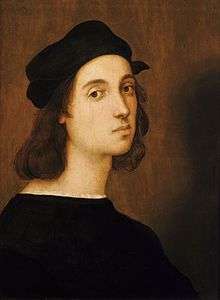Madonna of Foligno
_September_2015-1a.jpg) | |
| Artist | Raphael |
|---|---|
| Year | 1511 |
| Type | Oil on wood, transferred to canvas |
| Dimensions | 320 cm × 194 cm (130 in × 76 in) |
| Location | Pinacoteca Vaticana, Vatican City |
The Madonna of Foligno is a painting by the Italian High Renaissance painter Raphael. First painted on wood panel, it was later transferred to canvas.
History
The painting was executed for Sigismondo de' Conti, chamberlain to Pope Julius II, in 1511. It was placed on a high altar of the church of Santa Maria in Aracoeli on Capitoline Hill (Italian: Campidoglio) in Rome,[1][2] where Sigismondo was buried in 1512.
It was moved by Anna Conti, a descendant of Sigismondi Conti, to the monastery of St. Anne in Foligno in 1565 and remained there for more than two centuries, hence the name.[1][2]
In 1799 it was carried to Paris, France by Napoleon. There, in 1802, the painting was transferred from panel to canvas by Hacquin and restored by Roser of Heidelberg.[1][2] The process to transfer a painting from wood panel to canvas was so rare that special note was made by the restorer: "Rapporto dei cittadini Guijon Vincent Tannay e Berthollet sul ristauro dei quadri di Raffaello conosciuto sotto il nome di Madonna di Foligno." [3]
In 1815, after the Battle of Waterloo, it was returned to Italy, where it was placed in the room with the Transfiguration[1][2] in the Pinacoteca Vaticana of the Vatican Museum in the Vatican City.
Description
The painting is a sacra conversazione, where holy figures seem to be in conversation and draw the audience into their discussion.[4] Rather than sitting under a canopy, of the Umbrian or Florentine style,[2] the Virgin is seated on clouds, embracing Jesus, while surrounded by angels. They look down upon Sigismonde de' Conti, kneeling in a red, fur lined cape. Conti is presented by St. Jerome on the right with his lion, appealing for the Virgin's protection. On the left are the kneeling St. Francis of Assisi and St. John the Baptist, who is standing and wearing a tunic of skins. As St. John points to Jesus, he clearly looks out to us, pulling us in, while St. Francis points to us and looks at the Christ Child. Between the men is an angel, linking the saints of earth to the seraph host of heaven. Behind them are the towers of Foligno.[1][2][3][4][5]
Painted during Raphael's Roman period, it is a testament to his artist maturity, evidenced in the paintings composition, coloring and form.[3]
Conti commissioned the painting to commemorate his survival of a shell that exploded near him during the Siege of Foligno, his home town. He credited his safety to heavenly intervention.[2][3][4][5]
See also
References
- 1 2 3 4 5 Champlin, J; Perkins, C, eds. (1913). Cyclopedia of Painters and Paintings. 3. New York: Charles Scribner's Sons. p. 138.
- 1 2 3 4 5 6 7 Masters in Art: A Series of Illustrated Monographs. 1. Boston: Bates & Guild Company. 1900. p. 38.
- 1 2 3 4 Ricci, C (2003) [1914]. Vatican: Its History Its Treasures. Kessinger Publishing. p. 216. ISBN 0-7661-3941-7.
- 1 2 3 Hersey, G (1993). High Renaissance art in St. Peter's and the Vatican: An Interpretive Guide. Chicago: University of Chicago Press. p. 124. ISBN 0-226-32781-7.
- 1 2 Potter, M (1912). The Vatican: Being a Brief History of the Palace, and an account of the Principal Art Treasures within its Walls. Boston: The Botolph Society. p. 308.
